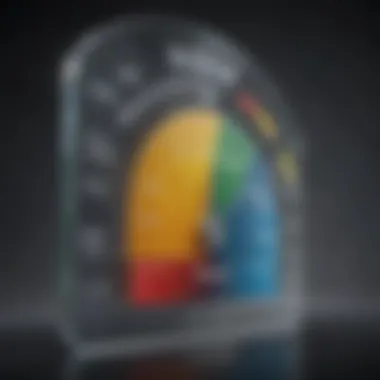Understanding a 582 Credit Score: Implications and Solutions


Intro
A credit score of 582 places an individual in the subprime category, suggesting a range of potential challenges when seeking various financial products. Understanding the implications of this score is essential for young professionals, families, and students navigating their financial landscape. The goal of this piece is to dissect what a 582 credit score means, the ways it impacts financial opportunities, and practical steps to improve one's score.
Credit scores are a crucial component in the lending process, influencing a person’s ability to secure loans, mortgages, and even insurance products. Yet many fail to grasp the significance of these numbers and their long-term consequences. In this guide, we will explore the overall characteristics of a 582 credit score, the various types of financial products affected by it, the application processes for those products, and strategies for effective improvement.
Overview of Financial Product
Definition
A credit score is a numerical representation of a person’s creditworthiness. Ranging from 300 to 850, it indicates how likely an individual is to repay borrowed money. A score of 582 is below the commonly accepted range for good credit.
Key Features
The main features of a credit score include:
- Payment history: The most significant factor, affecting 35% of the total score.
- Credit utilization: Accounts for 30%, showing the ratio of current debt to available credit.
- Length of credit history: This impacts 15% of the score and refers to how long credit accounts have been active.
- Types of credit: A diverse credit mix contributes 10% to the score.
- New credit inquiries: Each new inquiry accounts for 10%, representing how often credit applications are made.
Purpose and Benefits
Understanding credit scores helps individuals make informed financial decisions. A score of 582 signals lenders to assess an applicant's risk. Improving this score can lead to:
- Better loan terms
- Lower interest rates
- Access to a wider range of financial products
Types and Categories
Loan Types
Lending options may include personal loans, auto loans, and secured loans. A 582 credit score often limits access to favorable terms in these areas.
Credit Card Types
Cards available may fall into categories like secured, subprime, or retail cards. Each has various fees and interest rates, typically tilted unfavorably for subprime borrowers.
Mortgage Types
Securing a mortgage with a low score can lead to higher interest rates and the requirement for larger down payments. Options include FHA loans, which may offer better terms despite a low score.
Pros and Cons
Utilizing credit at this score level involves trade-offs. Pros:
- Access to some financial products
- Opportunity for credit rebuilding
Cons: - Higher interest rates
- Limited loan amounts
Situational Uses
Understanding when to apply for credit is key. For example, it might be wise to delay significant purchases until credit is improved, especially for essential loans like mortgages.
Application Process
Steps to Apply
- Check credit report: Review for inaccuracies.
- Research products: Look for lenders that specialize in subprime lending.
- Gather documentation: Ensure all required documents are ready.
- Submit application: Fill out applications carefully to avoid mistakes.
Eligibility Requirements
Requirements often vary by lender, but may include:
- Minimum monthly income
- Co-signer options
Documentation Needed
Typically required documents include:
- Proof of income
- Identification
- Current debt obligations
Common Mistakes to Avoid
Avoiding certain pitfalls can enhance the chances of approval. Double-check all application information and do not apply for multiple credit lines in a short time frame.


Tips for Success
- Focus on improving your credit score before applying.
- Consider speaking with a financial advisor for personalized advice.
Costs and Fees
Types of Fees Associated
Typical fees tied to loans and credit include origination fees, late payment fees, and annual fees for credit cards.
Interest Rates and APR for Loans/Cards
With a credit score of 582, expect to face higher interest rates than average, increasing the total cost of borrowing.
Foreword
Understanding a credit score is crucial for anyone looking to navigate the financial landscape, especially for young professionals, families, and students. A credit score is more than just a number; it encompasses a wide range of financial behaviors and decisions. This article focuses on a specific score—582—which falls into the subprime category.
A 582 credit score can significantly impact one’s financial opportunities. It can determine loan approval, affect interest rates, and limit credit options. Thus, understanding what this score means is essential for individuals who find themselves in this range.
Here, we will explore the significance of having a credit score in the first place. We will examine the components that contribute to a credit score and how these elements interact to create an overall financial picture. Moreover, we will offer actionable strategies to improve a 582 credit score, providing tools for managing credit in a responsible way.
Educating oneself about credit scores lends itself to making informed financial decisions, ultimately leading to better opportunities. It is not just about understanding where one stands, but also about knowing how to climb to a better financial position. As we delve into this subject, we will make the case for why improving a credit score should be a priority for many, hoping to enhance not only personal finance but also long-term economic well-being.
"Credit scores are not just algorithms; they reflect our financial habits and choices."
In this article, we aim to unravel the complexities associated with a 582 credit score, highlighting the associated challenges while also providing practical solutions for improvement. This comprehensive understanding will empower readers to take charge of their financial future.
The Significance of Credit Scores
Credit scores play a crucial role in the financial landscape today. They are not just numbers; they represent a person’s creditworthiness based on their credit history and financial behavior. Understanding credit scores can significantly impact an individual’s financial opportunities.
A solid credit score opens many doors. Lenders look at these scores when deciding whether to approve loan applications or extend credit. A higher score typically leads to better terms, such as lower interest rates and higher credit limits. In contrast, low scores can result in loan denials or unfavorable terms that restrict financial flexibility.
"Your credit score is a reflection of your reliability as a borrower. Higher scores mean better chances of loan approvals and more favorable conditions."
Definition of a Credit Score
A credit score is a numerical representation of a consumer's creditworthiness. Scores generally range from 300 to 850, with higher scores indicating lower risk to lenders. Credit bureaus collect information about an individual’s financial behaviors—like payment history, amounts owed, types of credit, and other factors—to generate these scores. Thus, your score can give lenders a snapshot of your financial responsibility.
Purpose of Credit Scoring
The primary purpose of credit scoring is to simplify the decision-making process for lenders. Instead of manually assessing every applicant's financial history, a credit score offers a standardized way to evaluate risk. This helps lenders determine whether to approve credit applications and establish terms. It also helps consumers understand their credit standing and take proactive steps towards improving it.
Components of a Credit Score
Several components contribute to an individual’s credit score:
- Payment history (35%): This is the most significant factor. It reflects whether credit obligations have been paid on time.
- Credit utilization (30%): This ratio compares total credit balances to total credit limits. A lower ratio is generally better.
- Length of credit history (15%): A longer credit history can benefit the score, showing a pattern of responsible credit use.
- Credit mix (10%): Having a variety of credit types—like credit cards, installment loans, and mortgages—can help improve a score.
- New credit inquiries (10%): Too many hard inquiries in a short period can negatively impact your score.
Understanding these components is crucial for anyone looking to improve their credit standing. A 582 credit score may present challenges, but knowing these factors can guide improvement efforts.
Understanding a Credit Score
A credit score of 582 is often classified as subprime, indicating a range of challenges for individuals with this score. Understanding what this score means is crucial for navigating financial opportunities. Knowing how credit scores function can assist in making informed decisions related to loans, credit cards, and overall financial health. It is important to be aware of potential difficulties, including higher interest rates and loan approval issues, that might arise with a score in this range.
Credit Score Ranges
Credit scores typically fall within a range of 300 to 850. Here’s a brief breakdown:
- 300-579: Poor
- 580-669: Fair
- 670-739: Good
- 740-799: Very Good
- 800-850: Excellent
A score of 582 lands in the fair category. Individuals with this score may have limited financial options. Lenders see these scores as higher risk, which can influence the terms of credit offered to them.
Is Considered Good?
Not at all. A score of 582 is not considered good. Rather, it signals potential difficulties in obtaining favorable credit terms. Individuals with a score in this range may face denial for loans or credit applications altogether. The implications of having a 582 credit score can also extend to insurance premiums and rental applications.
“Understanding your credit score can empower you to take steps towards improvement and better financial standing.”
Thus, while it is a wake-up call, those with a 582 score can still take actionable steps toward enhancement. Being informed is the first step in effectively managing credit health.


Challenges Associated with a Credit Score
Understanding the challenges associated with a 582 credit score is crucial for those aiming to enhance their financial position. This score categorization, landing in the subprime range, often leads to specific financial consequences that individuals need to navigate carefully. A comprehensive grasp of these challenges can empower individuals to take proactive steps towards improving their credit score and financial health.
Loan Approval Difficulties
A credit score of 582 significantly raises the chances of facing loan approval difficulties. Financial institutions typically use credit scores as a primary criterion to assess the risk of lending. With a score in this range, many lenders may classify applicants as high risk, leading to increased scrutiny. As a result, individuals may find it hard to secure loans for homes, cars, or personal needs.
Additionally, it is important to understand the psychological barrier that a low credit score can create during the application process. Repeated rejections can foster a sense of futility and discouragement.
Higher Interest Rates
A 582 credit score often results in borrowers being offered higher interest rates on loans and credit cards. Lenders view those with lower credit scores as more likely to default on repayments, leading to inflated costs to offset this risk. Over time, these higher interest rates can become a substantial burden.
For example, a 582 score might lead to personal loan interest rates that are anywhere from 5% to 10% higher than those offered to borrowers with higher scores. Over the what strikes as a minor credit choice can escalate into significant long-term costs.
"Higher interest rates can turn what seems like a manageable debt into a daunting financial obligation."
Understanding this aspect is important. Individuals must carefully consider the long-term implications of borrowing with a low score, including the potential for accruing more debt than intended.
Limited Credit Options
Another challenge linked to a 582 credit score is the limited credit options available. Many lenders might be unwilling to extend credit lines at all, while others may only offer secured credit cards or loans with unfavorable terms. This limitation not only restricts immediate borrowing capacity but can also hinder opportunities for rebuilding credit.
Some applicants may need to rely on subpar financial products, which may include high fees or unfavorable repayment terms. Therefore, it is crucial to explore alternatives such as credit unions or community banks that may offer more accessible options. By knowing where to look and what to expect, individuals with a 582 credit score can better navigate their circumstances.
These challenges underscore the importance of understanding the implications of a 582 credit score and actively seeking strategies for improvement. Facing loan approval difficulties, higher interest rates, and limited credit options can feel overwhelming. However, recognizing these hurdles is the first step in paving a path toward enhanced financial well-being.
Factors Impacting Your Credit Score
Your credit score is not a stagnant number; it changes based on various factors. Understanding these factors is critical for improving a 582 credit score and unlocking better financial opportunities. This knowledge equips individuals to take proactive steps to enhance their scores.
Payment History
Payment history is the most significant contributor to your credit score. Approximately 35% of your score is determined by whether you make your payments on time. Late payments can have a lasting impact, even if you catch up later. Establishing a reliable payment record strengthens your credit standing.
To keep your payment history spotless:
- Set up automatic payments for bills.
- Use calendar reminders.
- Communicate with creditors for possible extensions if you face financial difficulties.
Maintaining timely payments demonstrates financial responsibility and can positively influence your score incrementally over time.
Credit Utilization Ratio
Credit utilization makes up about 30% of your credit score calculation. This ratio measures the amount of credit you are using relative to your total available credit. For instance, if your total credit limit is $10,000 and you owe $3,000, your utilization is 30%.
Experts recommend keeping your credit utilization below 30%. A higher ratio can signal financial strain and negatively affect your score. Strategies to reduce this ratio include:
- Paying off balances each month.
- Requesting a credit limit increase, as long as you do not increase your spending.
- Limiting new credit applications that could result in higher outstanding balances.
Credit Age and New Credit
The age of your credit accounts combined with new credit inquiries contributes to the remaining 15% of your score. Lenders prefer borrowers with a longer credit history because it indicates stability and responsible credit behavior.
To improve your score in this category:
- Avoid closing old accounts, as this can reduce your average credit age.
- Be strategic when opening new accounts, understanding each inquiry can temporarily harm your score.
By focusing on these factors, you can take significant steps to enhance your credit score. The path to improvement involves diligence and a commitment to responsible credit management.
Remember, a credit score is not just a number. It reflects your financial habits and can heavily influence your borrowing options and interest rates.
Strategies for Improving a Credit Score
Improving a credit score, especially one that stands at 582, can feel overwhelming. However, understanding the strategic steps to enhance your credit profile can lead to better financial opportunities. This segment emphasizes actionable methods that can incrementally develop a stronger credit standing, opening doors to loans with favorable terms and interest rates.
Timely Payments
Timely payments are crucial in shaping your credit score. Payment history accounts for a significant portion of your overall score. Late payments can severely impact your score, pushing it down even further. Making consistent, on-time payments to credit cards, loans, and other financial obligations should be a top priority. Set reminders or automate payments when possible. This approach not only shields your score from dips but also builds a reputation with creditors, beneficial in the long term.


Reducing Credit Utilization
Credit utilization refers to the ratio of credit you’re using compared to your total available credit limit. Ideally, you should keep this ratio below 30%. A high utilization rate can signal to lenders that you may be overextending yourself financially. To reduce this ratio, consider paying off credit card balances in full each month. If that's difficult, make smaller, more frequent payments throughout the month. Additionally, asking for a credit limit increase can also help lower your utilization rate, provided you don’t increase your spending.
Monitoring Your Credit Report
Monitoring your credit report is crucial for understanding where you stand and what areas need improvement. Regular checks can reveal inaccuracies or outdated information, which can negatively affect your score. You are entitled to a free credit report from each of the major bureaus annually. Take advantage of these reports to dispute any errors promptly. Tools available online can help track your score changes over time and send alerts regarding significant changes. Keeping an eye on your report ensures that all information is accurate, giving you control over your credit health.
Establishing New Credit Responsibly
Establishing new credit can be a double-edged sword. When done responsibly, it can improve your credit mix and demonstrate creditworthiness. However, too many inquiries in a short period can negatively impact your score. If you decide to open a new credit account, do so thoughtfully. Focus on accounts that suit your financial needs and contribute positively to your credit profile, like a secured credit card or credit-builder loan. Ensure that any new debts are manageable and align with a strategy to maintain timely payments.
Improving a credit score is a gradual process that requires diligence and responsibility. Each step you take contributes positively to your financial future.
By implementing these strategies—focusing on timely payments, reducing credit utilization, monitoring credit reports, and responsibly establishing new credit—you can gradually improve your 582 credit score. The journey to a better credit score is achievable with consistent effort and informed decision-making.
The Role of Financial Literacy
Financial literacy is not just a desirable skill; it is essential in today’s economic climate, especially for individuals with a 582 credit score. Understanding the basics of credit can significantly influence financial decisions and opportunities. This section explores core aspects of financial literacy, illustrating its role in managing credit effectively and preventing common pitfalls.
Understanding Credit Basics
To navigate the financial landscape, one must comprehend the fundamentals of credit. A credit score is a numerical expression representing a person's creditworthiness based on their credit history. Key factors include payment history, credit utilization, and the types of credit accounts held.
- Payment History: This shows if you pay your bills on time. Missed or late payments can severely damage your score.
- Credit Utilization: This ratio compares current credit card balances to total credit limits. Ideally, keeping it below 30% is recommended.
- Credit Types: Having a mix of credit, such as revolving credit and installment loans, can also positively impact your score.
Educating oneself on these elements lays a strong foundation for improving and maintaining a healthy credit score.
Making Informed Financial Decisions
Awareness of how to utilize credit responsibly leads to more informed financial decisions. Being financially literate allows individuals to approach lending with caution and insight. It helps in evaluating loans, understanding interest rates, and recognizing the long-term implications of financial choices.
- Evaluate Loan Offers: Compare different lenders’ offers. Look beyond interest rates; consider fees and terms.
- Assess Borrowing Needs: Determine if a loan is necessary. Sometimes it is better to save up rather than incur debt.
- Plan for Future Payments: Structure budgets around loan repayments. Always ensure that repayments fit comfortably within your financial plan.
Resources for Credit Improvement
Understanding and improving your credit score is essential for long-term financial stability. This section explores various resources designed to assist individuals in enhancing their credit standing, particularly for those with a 582 credit score. Utilizing these resources can lead not only to better credit scores but also to a more informed financial future.
Credit Counseling Services
Credit counseling services play a pivotal role for individuals struggling with their credit scores. Much more than just advice, these services provide tailored guidance based on one's unique financial situation. They can help you understand your spending habits and offer practical solutions to manage debts effectively.
Benefits of Credit Counseling
- Personalized Financial Plans: Credit counselors can create a manageable budget that suits your needs and goals.
- Debt Management Plans: They may offer assistance in establishing a plan to pay off debts over time, which can help rebuild your score.
- Education: These services often include workshops on financial literacy that empower clients with knowledge.
Considerations
While many credit counseling services may offer help, it is crucial to choose a certified nonprofit organization. This ensures that the advice is unbiased and focused on your best interests. Research and read reviews to find credible counselors before engaging their services.
Online Tools and Calculators
In the digital age, online tools and calculators serve as valuable resources for credit improvement. They provide quick insights into how different financial actions can influence your credit score.
Popular Tools and Their Uses
- Credit Score Calculators: These tools allow you to estimate your future credit score based on potential changes in your financial behavior, such as paying off a credit card or taking out a loan.
- Budgeting Apps: Applications like Mint or YNAB help track spending, setting users on the path to improve their payment history.
- Credit Monitoring Services: Websites like Credit Karma provide free access to credit reports and scores, allowing users to stay informed about their credit status.
Benefits of Using Online Tools
- Instant Feedback: You can quickly see how different actions impact your credit score without waiting for traditional reporting.
- User-Friendly: Most tools are designed to be intuitive, making them accessible even for individuals with little financial know-how.
- Ongoing Monitoring: Regular use of these tools helps maintain awareness of your credit health, encouraging responsible financial management.
Investing time in using these resources is essential for credit score improvement and financial health.
Finale
Understanding the nuances of a credit score goes beyond mere numbers; it involves grasping the various factors that contribute to that score. The article outlined critical components such as payment history and credit utilization. These elements serve as crucial reminders for individuals striving to enhance their financial standing. Monitoring one’s credit reports regularly can help identify areas for improvement, making it a manageable task toward reaching a better score.
One must also consider the role of financial literacy in this discussion. By arming oneself with knowledge about credit—the processes, the implications, and the strategies for improvement—individuals can make informed decisions. This knowledgeable approach will ultimately lead to smarter financial choices and better outcomes in the credit landscape.
As addressed, actionable strategies such as timely payments and responsible management of credit can significantly aid in scoring improvements. It is vital for young professionals, families, and students to adopt these practices as they navigate their financial paths.
Credit scores are not static; they evolve based on choices and behaviors. Therefore, understanding a 582 credit score is crucial, but the proactive steps taken towards its improvement are equally vital. Engaging with resources and strategies outlined in this article can pave the way toward better financial opportunities and a more robust credit profile.
"Knowledge is the first step toward financial empowerment."
Recognizing the importance of maintaining and improving credit scores is an empowering realization. As such, it is critical to prioritize not only understanding one's current situation but also actively seeking to enhance it through informed decisions and responsible actions.



